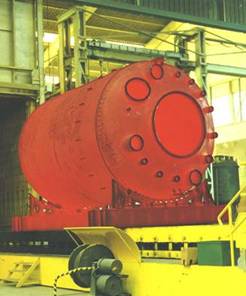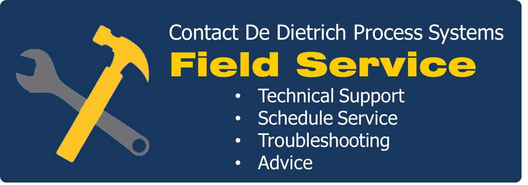The 10 Step Guide for Sending Glass-Lined Equipment in for Reglassing
 At some point, the addition of more plugs, patches or sleeves to your glass-lined vessel becomes uneconomical, or results in a repair of questionable integrity. When you’ve reached this stage in the lifecycle of your equipment it’s time to consider replacement or refurbishment. In last week’s post, we talked about reglassing – what it is, the advantages it offers over buying new equipment, and how it is performed. (If you are unfamiliar with reglassing, we suggest you read that article first to get up to speed on this service and how it could apply to your equipment.) All glass-lined reactors, tanks, columns, and accessories such as covers, agitators and baffles, can be reglassed if the steel substrate is in good or repairable condition. Once you’ve decided that your equipment is a candidate for reglassing these are the steps you should following for preparing your equipment to send in for service:
At some point, the addition of more plugs, patches or sleeves to your glass-lined vessel becomes uneconomical, or results in a repair of questionable integrity. When you’ve reached this stage in the lifecycle of your equipment it’s time to consider replacement or refurbishment. In last week’s post, we talked about reglassing – what it is, the advantages it offers over buying new equipment, and how it is performed. (If you are unfamiliar with reglassing, we suggest you read that article first to get up to speed on this service and how it could apply to your equipment.) All glass-lined reactors, tanks, columns, and accessories such as covers, agitators and baffles, can be reglassed if the steel substrate is in good or repairable condition. Once you’ve decided that your equipment is a candidate for reglassing these are the steps you should following for preparing your equipment to send in for service:
1. Clean exterior and interior of the vessel
Many processes involve toxic, flammable, or irritating constituents. It is essential that the vessel be thoroughly cleaned, so that it is free of product residue and contaminants, especially those which may generate flammable or toxic fumes when heated. Reactor jackets need to be cleaned thoroughly as well.
2. Remove all insulation
Exterior insulation must be removed prior to shipment. Insulation clips, rings, studs, etc. do not need to be removed.
3. Remove accessories
All accessories not subject to repair or replacement, such as the drive and agitation system, all split flanges and clamps, baffles, piping, fittings, instrumentation, etc. should be removed. The bare vessel should be shipped as one item; accessories like agitators and baffles should be shipped removed from the bare vessel. You can contact your reglassing vendor for clarification if you have any doubts as to what should and shouldn’t be removed.
4. Inspect and pre-qualify the vessel on-site
A service specialist, if requested, can visit your plant to inspect the vessel, making sure it's a logical candidate for reglassing. Before their visit, you should remove accessories as required for inspection and for making a preliminary evaluation. If the vessel is in reglassable condition, the De Dietrich service specialist will advise.
5. Prepare your vessel for shipment
Properly position and fasten the vessel, and any accessories, on sturdy shipping skids. If any special handling is required, be sure to notify the carrier and DDPS, and mark papers accordingly (read this post for tips on the proper handling of glass-lined vessels).
6. Obtain your Return Material Number
Call your reglass vendor (you can reach DDPS at 908-317-2585). You will be put in contact with the appropriate customer engineer, who will issue you an R/M Number (return material number) and answer any questions you have about the Return Equipment Questionnaire. Give the engineer your shipping information and requested delivery date. Be sure to use your identifying R/M Number on all paperwork, correspondence, bill of lading, etc., as well as marking it directly on the equipment with a weather-resistant crayon or paint.
7. Identify your equipment
In addition to your R/M Number, be sure your company name and address, your vessel number or location is put on all papers (e.g. shipping documents, purchase order) and affixed to the vessel or the shipping skid. (In order to preserve the National Board registry and ASME Code Rating of any pressure vessel, its legible nameplate must accompany the vessel! If no nameplate is available or legible, contact your vendor to discuss alternate methods available to obtain replacement nameplates, and/or other options.)
8. Fill out a Return Equipment Questionnaire
The Return Equipment Questionnaire can be submitted online and will provide your vendor with information about the equipment you plan to send in for reglassing, including last contents of the vessel and method of cleaning. It is required by both OSHA and our plant safety program to assure that all parties are aware of potential hazards (include MSDS if needed). A separate questionnaire needs to be filled out for each major item or each lot of small parts that are being reglassed.
9. Ship your equipment
Finally you are ready to ship your equipment to the vendor you’ve selected to perform your reglass service. If you are working with DDPS, unless otherwise advised, your equipment can be shipped to our Corpus Christi, TX facility at the following address:
De Dietrich Process Systems, Inc.
Route 44 and McKinzie Road
Corpus Christi, TX 78460
(512) 265-9900
10. Give yourself a pat on the back
Congratulations, you’ve just saved your company time and money by opting to reglass your existing equipment! When your equipment is returned to you it will come with the same standard warranty as new vessels so you can be assured you’ll have superior quality equivalent to what you would expect from a brand new vessel or part.

